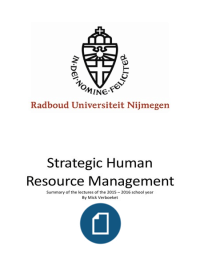Resume
Summary lectures SHRM (2015)
Summary of all lectures of SHRM (Strategic Human Resource Management) of the college year 2015/2016 for students of the Radboud University.
Samenvatting van alle colleges van SHRM van het collegejaar 2015/2016 voor studenten aan de Radboud Universiteit.
[Montrer plus]
Publié le
12 janvier 2016
Nombre de pages
42
Écrit en
2015/2016
Type
Resume
Établissement
Radboud Universiteit Nijmegen (RU)
Cours
Bedrijfskunde
Cours
Strategisch HRM
Tous les documents sur ce sujet (6)
S'abonner
Strategic




